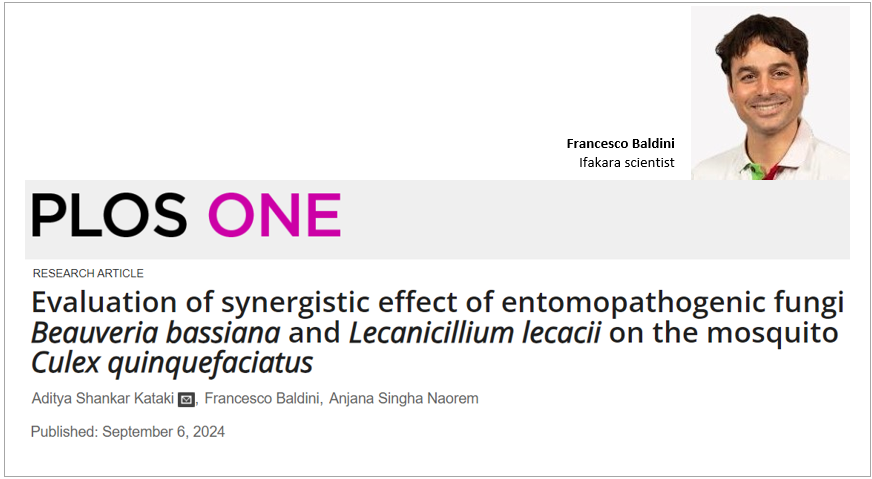
MALARIA CONTROL: Interesting! Did you know that fungi can be used to kill mosquitoes?

This is quite interesting! As the global challenge of insecticide resistance continues to raise concerns, scientists are now looking for innovative and sustainable alternatives to mosquito control. They are exploring fungi that naturally kill insects – as a safe alternative to traditional chemicals.
This type of fungi is technically named “entomopathogenic” fungi!
How “entomopathogenic” fungi work
Entomopathogenic fungi are natural pathogens that target insects, causing disease and death. Unlike synthetic chemical insecticides, these fungi offer a safer alternative and are less harmful to humans, animals, and the environment. Recent studies have tested their potential both alone and in combination with other control methods.
One recent study has examined the combined efficacy of two specific entomopathogenic fungi, Beauveria bassiana and Lecanicillium lecanii, against Culex quinquefasciatus, a common mosquito species responsible for various vector-borne diseases.
The study, led by scientists from the University of Glasgow (UK), Cotton University (India) and Ifakara Health Institute (Tanzania), focused on the effectiveness of these fungi when used together, rather than individually.
“The present study was an attempt to show the combined efficacy of the two entomopathogenic fungi B. bassiana and L. lecanii against C. quinquefasciatus population control. The research addressed significantly the fact that when the fungi are combined, they indeed show better efficacy than the two individual fungi in controlling population of C. quiquefasciatus,” wrote the scientists in their paper published in the PLOS journal.
"Several studies and experiments have demonstrated the potential use of entomopathogenic fungi for controlling mosquito vectors without jeopardizing the nature. It has been well cited in previous research experiments that entomopathogens can contribute to reducing selective pressure for pesticide resistance development in pest populations," they noted.
Key findings and results
The study found that combining B. bassiana and L. lecanii worked much better than using each fungus separately in controlling mosquito populations. By mixing the two fungal solutions, researchers achieved a tenfold increase in efficacy, with a notably lower lethal concentration (LC50) required to kill 50% of the mosquito larvae.
Further analysis using scanning electron microscopy (SEM) demonstrated that the combined fungal treatment led to noticeable deformities and death in the mosquito larvae, proving the combination was effective at killing them before they could grow into adults.
What this means for mosquito control
The results of this study have several important implications for mosquito control strategies. The success of the combined fungi suggests they could be a valuable tool in mosquito control programs such as Integrated Vector Management (IVM) programs. Applying these fungi to mosquito breeding sites, like stagnant water, could also help reduce the number of mosquitoes by killing larvae before they mature.
"It has been well cited in prior research and experiments that the fungal infection reduces the life span of insecticide resistant mosquitoes and thus entomopathogenic fungi can be used as a synergy in various insecticides or alone in IVM strategies," underscored the scientists.
Moreover, the research highlights the potential for using entomopathogenic fungi as part of a broader approach to tackle insecticide resistance. The method offers a sustainable and eco-friendly alternative to chemical insecticides, which mosquitoes are increasingly resistant to. It also shows promise for use in combination with other control methods.
More research needed to explore entomopathogenic fungi
Despite these promising findings, further research is needed to explore the full potential of entomopathogenic fungi. Scientists recommend that future studies should focus on assessing the feasibility of using these fungi in various applications, such as aerosols for other pests, and determining their safety and efficacy across different ecosystems.
By continuing to investigate and improve these innovative approaches, researchers and public health professionals can work together to address the growing challenge of insecticide resistance and enhance the ability to control mosquito-borne diseases.
Ifakara scientist contributes
The study was led by Aditya Shankar Kataki from the University of Glasgow, with contributions from Francesco Baldini, also from the University of Glasgow and affiliated with Ifakara Health Institute, and Anjana Singha Naorem from Cotton University.
Read the publication here.
